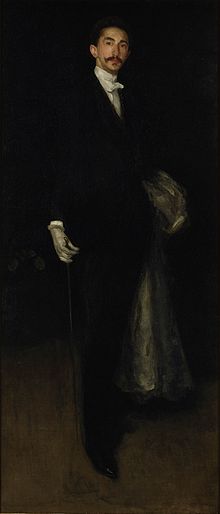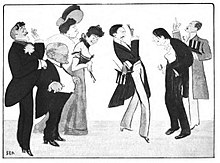Robert de Montesquiou
Robert de Montesquiou | |
|---|---|
| Comte de Montesquiou-Fézensac | |
 Portrait by Giovanni Boldini, 1897 | |
| Born | Marie Joseph Robert Anatole de Montesquiou-Fézensac 7 March 1855 |
| Died | 11 December 1921 |
| Noble family | Montesquiou |
| Father | Thierry, Comte de Montesquiou-Fézensac |
| Mother | Pauline Duroux |
| Occupation |
|
Marie Joseph Robert Anatole, Comte de Montesquiou-Fézensac (7 March 1855, Paris – 11 December 1921, Menton), was a French aesthete, Symbolist poet, art collector and dandy. He is reputed to have been the inspiration both for Jean des Esseintes in Joris-Karl Huysmans' À rebours (1884) and, most famously, for the Baron de Charlus in Marcel Proust's À la recherche du temps perdu (1913–1927).[1] He also won a bronze medal in the hacks and hunter combined event at the 1900 Summer Olympics.[2]
Biography


Robert de Montesquiou was a scion of the French Montesquiou-Fézensac family. His paternal grandfather was Count Anatole de Montesquiou-Fézensac (1788–1878), aide-de-camp to Napoleon and grand officer of the Légion d'honneur; his father was Anatole's third son, Thierry, who married Pauline Duroux, an orphan, in 1841. With his wife's dowry, Thierry bought a Charnizay manor, built a mansion in Paris, and was elected Vice-President of the Jockey Club. He was a successful stockbroker who left a substantial fortune. Robert was the last of his parents' children, after brothers Gontran and Aymery, and sister Élise.[1] His cousin, Élisabeth, Countess Greffulhe (1860–1952), was one of Marcel Proust's models for the Duchess of Guermantes in À la recherche du temps perdu.[3]
Montesquiou had a strong influence on Émile Gallé (1846–1904), a glass artist he collaborated with and commissioned major works from, and from whom he received hundreds of adulatory letters. He also wrote the verses found in the optional choral parts of Gabriel Fauré's Pavane.
The portrait Arrangement in Black and Gold: Comte Robert de Montesquiou-Fezensac was painted in 1891–92 by Montesquiou's close friend, and model for many of his eccentric mannerisms, James Whistler. The French artist Antonio de La Gandara (1861–1917) produced several portraits of Montesquiou.
One author provides the following verbal portrait of Montesquiou: "Tall, black-haired, Kaiser-moustached, he cackled and screamed in weird attitudes, giggling in high soprano, hiding his black teeth behind an exquisitely gloved hand—the poseur absolute. Montesquiou's homosexual tendencies were patently obvious, but he may in fact have lived a chaste life. He had no affairs with women, although in 1876 he reportedly once slept with the great actress Sarah Bernhardt, after which he vomited for twenty-four hours. (She remained a great friend.)"[4]

Montesquiou had social relationships and collaborations with many celebrities of the fin de siècle period, including Alphonse Daudet (1840–1897), Edmond de Goncourt (1822–1896), Eleonora Duse (1858–1924), Sarah Bernhardt (1844–1923), Gabriele d'Annunzio (1863–1938), Anna de Noailles (1876–1933), Marthe Bibesco (1886–1973), Luisa Casati (1881–1957), Maurice Barrès (1862–1923), and Franca Florio.[1]
While Montesquiou had many aristocratic women friends, he much preferred the company of bright and attractive young men. In 1885, he began a close long-term relationship with Gabriel Yturri (March 12, 1860 – July 6, 1905), a handsome South American immigrant from Tucuman, Argentina, who became his secretary, companion, and lover. After Yturri died of diabetes, Henri Pinard replaced him as secretary in 1908 and eventually inherited Montesquiou's much reduced fortune. Montesquiou and Yturri are buried alongside each other at Cimetière des Gonards in Versailles, Île-de-France, France.
A chronology of Montesquiou's life can be found at the website of the University of Napierville, Quebec.[5]
'An Adventure'
In his biography, Philippe Jullian proposes that Moberly and Jourdain's 'Adventure' in 1901 in the grounds of the Petit Trianon is explained by their stumbling into a rehearsal of one of Montesquiou's Tableaux Vivants, with his friends (one possibly transvestite) dressed in period costume. Joan Evans, who owned the copyright to 'An Adventure', accepted this solution and forbade any further editions.
Works
Montesquiou's poetry has been called untranslatable,[6] and it was poorly received by critics at the time.[1]
Poetry
Note that there is original text related to this article at: French Wikisource
- Les Chauves-Souris, Clairs obscurs (Richard, édition privée : 1892, édition commercialisée : 1893 ; illustrated by Madeleine Lemaire, James McNeill Whistler and Antonio de La Gandara).
- Le Chef des odeurs suaves, Floréal extrait (Richard, 1893)
- Le Parcours du rêve au souvenir (Charpentier et Fasquelle, 1895)
- Les Hortensias bleus (Charpentier et Fasquelle, 1896)
- Les Perles rouges : 93 sonnets historiques (Charpentier et Fasquelle, 1899)
- Les Paons (Charpentier et Fasquelle, 1901)
- Prières de tous : Huit dizaines d'un chapelet rythmique (Maison du Livre, 1902)
- Calendrier Robert de Montesquiou pour 1903
- Calendrier Robert de Montesquiou 1904
- Passiflora (L'Abbaye, 1907)
- Les Paroles diaprées, cent dédicaces (Richard, 1910)
- Les Paroles diaprées, nouvelle série de dédicaces (Richard, 1912)
- Les Offrandes blessées : elégies guerrières (Sansot, 1915)
- Nouvelles Offrandes blessées (Maison du Livre, 1915)
- Offrande coloniale (1915)
- Sabliers et lacrymatoires : elégies guerrières et humaines (Sansot, 1917)
- Un moment du pleur éternel : offrandes innommées (Sansot, 1919)
- Les Quarante bergères : Portraits satiriques..., avec a frontispiece de Aubrey Beardsley (Librairie de France, 1925)
Essays
- Félicité : étude sur la poësie de Marceline Desbordes-Valmore, suivie d'un essai de classification de ses motifs d'inspiration (Lemerre, 1894)
- Roseaux pensants (Charpentier et Fasquelle, 1897)
- Apollon aux lanternes (Albert Lanier, 1898)
- Autels privilégiés (Charpentier et Fasquelle, 1898)
- Alice et Aline, une peinture de Chassériau (Charpentier et Fasquelle, 1898)
- Musée rétrospectif de la classe 90 ((parfumerie (matières premières, matériel, procédés et produits): a l'Exposition universelle internationale de 1900, a Paris), Belin Frères, 1900)
- Alfred Stevens (1823–1906) (extrait de la Gazette des Beaux-Arts, 1900)
- Pays de aromates (Floury, 1900)
- L'Inextricable graveur : Rodolphe Bresdin (Richard, 1904)
- Professionnelles beautés (Juven, 1905)
- Altesses sérénissimes (Juven, 1907)
- Assemblée de notables (Juven, 1908)
- Saints d'Israël (Maison du livre, 1910)
- Brelan de dames : essai d'après trois femmes auteurs (Fontemoing et Cie, 1912)
- Têtes d'expression (Emile-Paul Frères, 1912)
- Paul Helleu, peintre et graveur (Floury, 1913)
- Têtes Couronnées (Sansot, 1916)
- Majeurs et mineurs (Sansot, 1917)
- Diptyque de Flandre, Triptyque de France (Sansot, 1921)
- Les Délices de Capharnaüm (Émile-Paul Frères, 1921)
- Elus et Appelés (Émile-Paul Frères, 1921)
- Le Mort remontant (Émile-Paul Frères, 1922)
Novels
- La Petite mademoiselle (Albin-Michel, 1911)
- La Trépidation (Emile-Paul Frères, 1922)
Biographies
- Le Chancelier de fleurs : douze stations d'amitié (Maison du livre, 1907)
- La Divine Comtesse : Étude d'après Madame de Castiglione (Virginia Oldoini) (Goupil, 1913)
- L'Agonie de Paul Verlaine, 1890-1896 (M. Escoffier, 1923)
Theatre
- Mikhaïl, Mystère en quatre scènes, en verses (d'après Tolstói) (1901)
Memoirs
- Les Pas effacés, 3 vol. (Émile-Paul Frères, 1923; réed. Editions du Sandre, 3 vol)
References
- ^ a b c d Prince Of Aesthetes: Count Robert de Montesquiou (1855-1921), Philippe Jullian, The Viking Press, 1968
- ^ Evans, Hilary; Gjerde, Arild; Heijmans, Jeroen; Mallon, Bill; et al. "Robert de Montesquiou Olympic Results". Olympics at Sports-Reference.com. Sports Reference LLC. Archived from the original on 17 April 2020. Retrieved 12 April 2020.
- ^ Tadié, Jean-Yves, Marcel Proust, Viking, New York, 2000
- ^ Sansom, William, Proust and His World, Scribner, New York, 1973
- ^ Udenap.org
- ^ Munhall, Edgar, Whistler and Montesquiou. The Butterfly and the Bat, New York, 1995
Further reading
- Robert de Montesquiou, mécene et dandy, Patrick Chaleyssin, Somogy, 1992
- Robert de Montesquiou, Les Pas effacés, Suivi d'une étude de Thanh-Vân Ton-That, Editions du Sandre, Paris
- Elegant Wits and Grand Horizontals, Cornelia Otis Skinner, Houghton Mifflin, Boston, 1962
External links
- Works by Robert de Montesquiou at LibriVox (public domain audiobooks)

- 1855 births
- 1921 deaths
- French poets
- Gay writers
- LGBT writers from France
- Counts of Montesquiou-Fezensac
- Gay nobility
- Writers from Paris
- LGBT poets
- French male poets
- French socialites
- French male equestrians
- Olympic equestrians of France
- Equestrians at the 1900 Summer Olympics
- Olympic bronze medalists for France
- Olympic medalists in equestrian
- Medalists at the 1900 Summer Olympics
